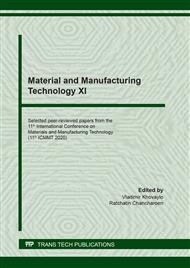[1]
Tsou, C. H., Lee, H. T., Hung, W. S., Wang, C. C., Shu, C. C., Suen, M. C., & De Guzman, M.. Polymer, 2016, 85, 96–105.
Google Scholar
[2]
M. Z. Rong, M. Q. Zhang, Y. X. Zheng, H. M. Zeng, R. Walter, and K. Friedrich: submitted to Polymer (Guildf) (2001).
Google Scholar
[3]
K. Prashantha, J. Soulestin, M.F. Lacrampe, P. Krawczak, G. Dupin, and M. Claes: submitted to Composites Science and Technology (2009).
DOI: 10.1016/j.compscitech.2008.10.005
Google Scholar
[4]
Tsou, C. H.; Wu, C. S.; Hung, W. S.; de Guzman, M. R.; Gao, C.; Wang, R. Y.; Suen, M. C. Polymer 160, 265−271. (2020).
Google Scholar
[5]
Yao YL, et al. Chinese Journal of Polymer Science, 7(3): 119-123. doi.org/10.1007/s10118-020-2392-z. (2020).
Google Scholar
[6]
Tsou, C H, Yao WH, et al. Polymers, 9, 100−113 (2017).
Google Scholar
[7]
A. I. Aji, D. Praseptiangga, E. Rochima, I. M. Joni, and C. Panatarani: AIP Conference Proceedings Vol. 1927(1) (2018), p.030039.
Google Scholar
[8]
W. Hao, P. Ling, Z. Huang, and S. Mei: submitted to Journal of Molecular Structure (2014).
Google Scholar
[9]
F. Caruso: submitted to Chemistry–a European journal (2000).
Google Scholar
[10]
T. Yao, Q. Lin, K. Zhang, D. Zhao, H. Lv, J. Zhang, and B. Yang: submitted to Journal of Colloid and Interface Science (2007).
Google Scholar
[11]
C. Zhao, B. Yu, B. Qian, W. Qiang, K. Yang, and A. Zhang: submitted to Journal of Membrane Science (2008).
Google Scholar
[12]
S. Atchariyawut, C. Feng, R. Wang, R. Jiraratananon, and D. T. Liang: submitted to Journal of Membrane Science (2006).
Google Scholar
[13]
C. Wang, X. Cheng, X. Zhou, P. Sun, X. Hu, K. Shimanoe, G. Lu and N. Yamazoe: submitted to ACS applied materials & interfaces (2014).
Google Scholar
[14]
X. M. Yin, C. C. Li, M. Zhang, Q. Y. Hao, S. Liu, Q. H. Li, L. B. Chen and T. H. Wang: submitted to Nanotechnology (2009).
Google Scholar
[15]
Tsou, C. H.; Yao W. H.; Hung W. S.; Suen M. C.; de Guzman, M. R.; Chen J.; Tsou C. Y.; Wang R. Y.; Chen J. C.; Wu C. S. Ind. Eng. Chem. Res. 57, 2537−2545 (2018).
DOI: 10.1021/acs.iecr.7b04693
Google Scholar
[16]
W. C. Xu, D. L. Li, Y. B. Fu, and W. Shang: submitted to Advanced Materials Research (2013).
Google Scholar
[17]
D. N. Bikiaris, G. Z. Papageorgiou, P. Palatzoglou, E. Pavlidou, N. Vouroutzis, and G. P. Karayannidis: submitted to Journal of applied polymer science (2010).
Google Scholar


